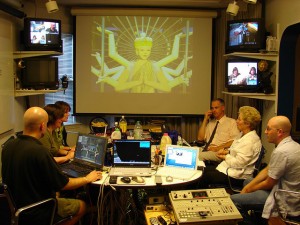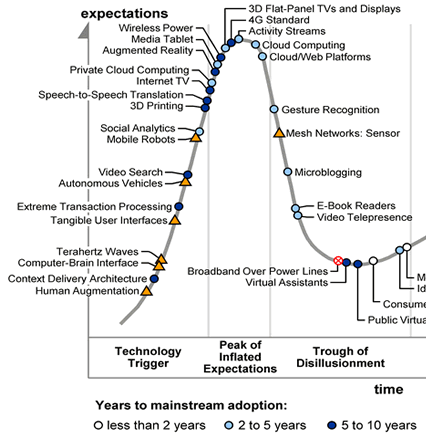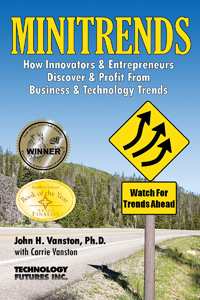InnoTech Conference Teeming With Emerging Trends
October 25, 2011

Sean Lowry, Exe. Dir., Innotech and Carrie Vanston, Co-Author, MINITRENDS at Innotech Conference, Photo by Sloan Foster
I’ve attended the InnoTech Conference and Expo and its associated eMarketing Summit for several years now and always learn a lot. This year I wanted to pass on some comments from experts that I heard yesterday relating to emerging trends that are becoming more and more important:
Sean Lowry, of the very successful InnoTech series, always does a great job of making sure everything runs smoothly. I was even able to steal him for a minute to ask what emerging trends he saw coming. He told me, “I see continued convergence of all the different technologies we are seeing here today. Development of mobile applications and host applications in the cloud are particularly important. There is so much video activity and a lot of it is being hosted in the cloud now.”
I asked Giovanni Galluci, social media expert and Dallas photographer what he thinks the next trend in social media is going to be. He said, “Getting over it. Everyone is burnt out with all the hype and now people are looking for more meaning in social media. Twitter is ridiculous. Those who do marketing are beginning to realize it. Online social media is becoming part of the umbrella of marketing, which is where it belongs. Social media is becoming more commodatized—as in more of a commodity.”
He gave several great hints about Facebook including that Facebook ads are the best way to grow a fan base; Facebook is the 2nd largest search engine, so take advantage of it (including using pictures with metatags, main key words in description, etc.); and put Facebook info on all your printed matter including cards and bills.
I chatted with William Leake, CEO of Apogee Search Marketing, and his take was that “More and more advertising presence is going to be driven by physical location. If you don’t have a physical location strategy, you are going to lose.”
Craig Wax, CEO of Invodo and a video expert, had a lot to say about the future of video marketing. According to Craig, “In the future, no one is going to stand in line anymore. Offline and online is no longer relevant. This is already starting to happen and it is going to become ubiquous.” He added that “QR readers are going to be incorporated into devices and the present obstacles to their use will be chipped away.” (On a side note, Craig was most recently the Senior Vice President and General Manager at Match.com. That had to be an interesting job!)
According to Pat Scherer, Web and Mobile Deployment Manager at The Detail Person, “Mobile space is going to be huge. With the explosion of devices, I think it’s going to make a huge impact on the retail industry. Not only for payments, but for creating local-based experiences utilizing mobile social media. I anticipate this leveling the playing field with e-commerce.”
Finally, I got to chat briefly with siblings Kevin Olsen and Kerri Olsen, Co-Founders of the Austin Grand Prix. Having Formula 1 in Austin exciting!
Cheers,
Carrie Vanston
Media/Marketing Director, Technology Futures, Inc.
Co-Author, MINITRENDS: How Innovators & Entrepreneurs Discover & Profit From Business & Technology Trends
Google, Yahoo Struggle with Technology Innovation
March 30, 2011
 Google is taking a slice from Apple’s strategy, bringing back company co-founder Larry Page to ignite innovation at Google, where the stock has flatlined for the past year. Page is scheduled to take over next week as CEO from Eric Schmidt, who is reportedly under consideration for the Secretary of Commerce position in U.S. President Barack Obama’s cabinet.
Google is taking a slice from Apple’s strategy, bringing back company co-founder Larry Page to ignite innovation at Google, where the stock has flatlined for the past year. Page is scheduled to take over next week as CEO from Eric Schmidt, who is reportedly under consideration for the Secretary of Commerce position in U.S. President Barack Obama’s cabinet.
It’s often difficult for mature companies to innovate the way startups do. For one thing, they lack the financial compulsion that drives entrepreneurs to market or die. Look at how News Corp. has shouldered losses at MySpace while Facebook restlessly innovates, or what happened to AOL after the merger with Time Warner, or what might happen to The Huffington Post now that it has been acquired by AOL. Google can afford to simply hold onto a company such as YouTube without the pace of self-improvement often seen in startups.
Amir Efrati, who covers the Internet for The Wall Street Journal, has been stirring things up in Silicon Valley this past week with fascinating reports on attempts by Google and Yahoo to stay innovative. In an article last Saturday, Efrati used unnamed sources to speculate that Larry Page is being called back to “speed up what [Page] says has been sluggish decision-making at Google’s top levels.”
One of Page’s new edicts, according to The Wall Street Journal, is face-to-face bullpen sessions:
… [E]very afternoon, [Page] and the company’s executive officers sit and work on small couches outside a boardroom in Building 43 at Google’s headquarters.
That might have worked when Page left the company in 2001, with 200 employees. Whether it will work 10 years later, with over 100 times as many people on the payroll, remains to be seen.
The difficulty of fostering innovation in mature companies is one of the main drivers behind the Minitrends project at Technology Futures, Inc., the Austin, Texas, technology forecasting firm and publisher of the book, MINITRENDS, and this blog. The authors devote a significant portion of the book to fostering innovation in large corporations:
Fewer than 30 percent of the companies listed on the Fortune 100 twenty-five years ago are still on the list today. Often the primary reason for the demise of such companies has been a failure to recognize and react to changing trends.
One of the ways that companies innovate is through acquisition rather than invention. Efrati generated a second round of buzz this week when he quoted Yahoo’s director of development, Steven Mitzenmacher, on The Wall Street Journal‘s Digits blog as saying Google’s investment in YouTube was “crazy.” It’s an odd comment, given YouTube’s burgeoning revenues and the fact that Yahoo is embarking on a buying binge to remain relevant.
Savvy institutional investing reporter, Riley McDermid, follows the fallout from Page’s return to Google in an insightful article at VentureBeat. Always one step ahead of the competition, McDermid managed to write about The Wall Street Journal‘s article a day before the article appeared. It’s hard to keep up with futurists!
So where do large corporations find the stimulation they need to stay at the forefront of technology trends? Among the resources mentioned in MINITRENDS are innovation competitions and working papers. Among the best examples of where to find both is the National Collegiate Inventors and Innovators Alliance (NCIIA), which held its version of “March Madness” — an innovation competition — in Washington, D.C., last Saturday.
The NCIIA competition is sponsored by companies that are working to stay competitive and rewarding innovation in education. The NCIIA has already published all the conference papers online, for free; they contain a treasure-trove of ideas for mature companies looking for a little stimulation or entrepreneurs looking for adventure.
If you prefer to watch rather than read, we recommend you screen the videos submitted to the NCIIA’s “Open Mind” Awards and nicely catalogued by David Orsman at Inventors Digest. It’s by doing research like this that you are likely to find the Larry Pages and Steve Jobs of tomorrow, who will set the technology trends that others follow.
STEVE O’KEEFE
News Editor, Minitrends Blog
Source: “Obama Nears Appointment Of Eric Schmidt As Commerce Secretary,” BusinessInsider, March 18, 2011
Source: “At Google, Page Aims to Clear Red Tape,” The Wall Street Journal,” March 26, 2011
Source: “Larry Page already cracking the whip at Google, a week before he takes the reins,” VentureBeat, March 25, 2011
Source: “Yahoo Executive Talks Acquisitions, Slams YouTube Buy,” The Wall Street Journal‘s Digits Blog, March 28, 2011
Source: “The Open Minds Awards: Taking Innovation off Campus & into Commercialization,” Inventors Digest, Feb. 18, 2011
Photo courtesy of Jeff Keyzer (mightyohm), used under its Creative Commons license.
“Nine Emerging Minitrends to Watch” by Dr. John H. Vanston, MINITRENDS Author & Chairman, TFI
December 28, 2010
 Happy holidays to Minitrends blog readers! We appreciate your interest in our Minitrends posts and activities. As we start the new year, there will be many opportunities for those who are alert enough to recognize emerging trends, perceptive enough to realize their importance, and clever enough to take advantage of them. Here I suggest nine Minitrends—emerging trends that will become significantly important within 2-5 years, but are not yet generally recognized—that are well worth examining for possible action by those ambitious individuals who seek to start new ventures or keep existing businesses innovative and competitive.
Happy holidays to Minitrends blog readers! We appreciate your interest in our Minitrends posts and activities. As we start the new year, there will be many opportunities for those who are alert enough to recognize emerging trends, perceptive enough to realize their importance, and clever enough to take advantage of them. Here I suggest nine Minitrends—emerging trends that will become significantly important within 2-5 years, but are not yet generally recognized—that are well worth examining for possible action by those ambitious individuals who seek to start new ventures or keep existing businesses innovative and competitive.
Unlike megatrends, Minitrends are of a scope and importance to offer attractive opportunities to individual entrepreneurs, decision-makers in small and mid-size businesses, innovative thinkers in large companies, and adventuresome investors. In my new book, MINITRENDS: How Innovators & Entrepreneurs & Discover & Profit From Business & Technology Trends, I categorize the nine Minitrends below to those most applicable to different-sized groups. (In the book, I also discuss the background, current trends, and business opportunities of each of these Minitrends in more depth.) I do the same categorization below, but in reality, all provide opportunities to perceptive individuals in all-sized businesses.
Minitrends Particularly Applicable to Individuals or Small Groups of Individuals:
1. Expanding Involvement in Virtual Worlds (Free Virtual Worlds book excerpt available):
Virtual worlds are computer-based platforms that allow participants to engage in a wide range of real-world type activities, e.g., buying and building virtual world property, furnishing virtual world homes and offices, producing and selling virtual world goods, traveling, taking part in virtual world social activities such as parties and fundraisers, and communicating with other participants. Increasingly, virtual worlds are being used for educational purposes, product advertisements, new product modeling and testing, identification of new markets, and uncovering unexpected problems with new marketing programs.
2. Support for People Working at Home:
Although an increasing number of people are now conducting all or part of their work at home, these people often find they miss interacting with others and miss the convenience of facilities, equipment, and administrative support. A number of solutions are emerging to better meet the needs and desires of people working at home, including small offices or meeting rooms that can be rented by the day or the hour; chat rooms where people can meet informally to discuss ideas; semiformal groups that meet regularly to establish person-to-person interactions; and temporary support staffs organized to provide administrative assistance as needed.
3. Expanding Capabilities of Advanced Websites:
Although the World Wide Web had proven to be extremely popular, many believed a more interactive platform that took advantage of the Web’s power to communicate would be desirable (Web 2.0). Programmers are now expanding the capabilities of the Web to substitute computer activities for human activities, particularly activities that are repetitive, burdensome, and uninteresting (Web 3.0). Many believe Web 3.0 will eventually lead to effective artificial intelligence that can interact with humans in natural language.
Minitrends Particularly Applicable to Small and Medium-Size Companies:
4. Increasing Interest in Privacy:
Recent advances in technology, together with an increasing willingness of many to make personal information more easily available are threatening traditional concepts of privacy in terms of messaging, personal profiles, and identity. Techniques for countering these invasions of privacy, such as personal caution, technology aids, and group action are now being developed.
5. New Approaches to Giving and Receiving Advice:
Individuals and organizations commonly seek expert advice when making important decisions. In providing such advice, large consulting firms with large, multidisciplinary staffs, well-structured processes and procedures, huge computer capabilities, and long-standing reputations have traditionally had a major advantage. However, the ever-increasing power and ubiquity of information gathering, processing, and communicating technologies, small and medium-size consulting groups are often able to give more focused, timely, and user-friendly advice than the larger firms.
6. Evolution of Meaningful Maturity:
The twin trends of increasing life spans and decreasing retirement ages have caused a steady increase in retirement years. Because of social, personal interest, and/or financial reasons, many older individuals are either staying in their jobs longer or returning to the workforce. Their ability to utilize their experience, skills, and dedication effectively will depend on their current capabilities, their desires, and open opportunities to those willing to assist them.
Minitrends Particularly Applicable to Large Companies:
7. Advances in Digital Manufacturing:
Advanced digital manufacturing (ADM) processes build complex, custom-made parts by the addition of successive layers of material rather than traditional machining processes that cut, bend, and machine a part from stock material. The processes allow quicker production of prototypes and small production runs at a much lower cost. Recent ADM advances, including improved yield rates, reduced time-to-market, increasing variety of materials, and advances in 3D modeling software, have made ADM processes increasingly attractive to many manufacturers.
8. Increasing Electricity Use in Manufacturing:
The characteristics of electric power, such as high power density, no heat transfer medium requirements, controlled energy distribution, reduced material waste, and less environmental impacts, provide a number of benefits to manufacturing processes. Its use, however, has been limited by its relatively high cost. A number of factors, including advances in control technologies, changing customer needs, global competition, and increasing concern about the environment, are driving an increasing growth in the use of electricity in industrial processes.
9. New Applications of Nanotechnology:
When many substances are reduced to nano-size (100 nanometers or less) they often exhibit very different physical, electrical, chemical, and optical properties from the same substance at macro-size. These new properties often provide very unique and useful characteristics to nano-materials that can be used in a wide range of practical applications, such as cancer treatment, very high strength materials, special electronic systems, and water purification. Improved production techniques, decreased costs, and growing experience and understanding are increasing the practical applications of nanotechnologies
Minitrend involvement can give you a way to separate yourself from your colleagues and contemporaries. It provides a means for materially improving your business situation, your financial standing, and your personal satisfaction. I hope the Minitrends listed above will assist you or inspire you to launch your own exciting, profitable Minitrend Adventure that allows you to utilize your imagination, your logic, your innovative nature, and your basic good sense in the coming year.
Copyright 2011. Please feel free to reprint this article in whole or part with due credit to: “by Dr. John H. Vanston, MINITRENDS Author and Chairman, Technology Futures, Inc.” Thanks!
Robots Get Emotional, Social Too
November 1, 2010
 One of the most difficult challenges for robot designers is to give the machines realistic emotional responses to human beings. ScienceDaily reports on a breakthrough in robot vision that allows robots to see and react to human facial expressions.
One of the most difficult challenges for robot designers is to give the machines realistic emotional responses to human beings. ScienceDaily reports on a breakthrough in robot vision that allows robots to see and react to human facial expressions.
The researchers, Wei-Po Lee, Tsung-Hsien Yang and Bingchiang Jeng of National Sun Yat-sen University, have now turned to neural networks to help them break the cycle of repetitive behavior in robot toys and to endow them with almost emotional responses to interactions.
The neural networks allow robotic pets to learn based on visual and audio cues given off by their owners. For example, pets can learn their own names, respond only to the voice of their primary caretaker, and react to facial expressions such as smiling, frowning, or blinking.
Engadget’s prolific associate editor, Ross Miller, recently played with a new robot teddy bear manufactured by Fujitsu but not yet available on the market. The bear responds to a variety of visual cues through a camera in its nose. For example, it can see people waving at it, and will wave back.
This new breed of mechanical companions are called “social robots,” for their ability to respond to environmental signals. Parag and Ayesha Khanna explain the concept in a post a few days ago on the BigThink blog:
They will ‘respond’ and ‘react’ to us, which will make us care for them much as we care for pets and other humans. Eventually, almost all robots will have this interactive social side to them.
One of the earliest robot pets, Pleo, has been given a makeover for the 2010 holiday season. Shane McGlaun, a gadget geek who writes for a number of tech trend sites, including DailyTech and the Gadgets Weblog, recently filed a review for SlashGear on the revamped robot dinosaur, dubbed “Pleo RB” for “Pleao reborn”:
The new design also knows the time of day and will alter its behavior to suit the time of day by wanting to be fed in afternoons and being sleepy at night.
Robotic pets are ripe for Minitrends adventures. As ScienceDaily reports, one of the struggles with the popular playmates is to advance the technology as quickly as consumers expect new features. Conditioned by films such as Avatar, consumers demand a lot from their robot companions. Inventors struggle to keep pace, knowing that they will have only a short time to earn back their investments before the public loses interest in outdated features.
STEVE O’KEEFE
News Editor, Minitrends Blog
Source: “Emotional Robot Pets,” ScienceDaily, 09/20/10
Source: “Fujitsu’s social robot bear is the supertoy of Kubrick’s dreams, almost,” engadget, 10/05/10
Source: “Loving Robots – Come On, You Can Do It,” BigThink, 10/30/10
Source: “Innvo Pleo baby dinosaur gets updated and new colors,” SlashGear, 10/18/10
Image by Travis Isaacs, used under its Creative Commons license.
New Forrester Report on Technology Trends Highlights Customer Communities
October 19, 2010
 Microsoft’s resident business psychologist Bill Ives recently offered a sneak preview of a new Forrester report on “The Top 15 Technology Trends EA Should Watch: 2011 To 2013.”
Microsoft’s resident business psychologist Bill Ives recently offered a sneak preview of a new Forrester report on “The Top 15 Technology Trends EA Should Watch: 2011 To 2013.”
Forrester has some interesting technology terminology. An “EA,” for example, is an “enterprise architect,” a pretty slick new term for an entrepreneur, CEO, or the person who calls the shots — if not for the company, then for some significant division of the company, such as the IT department. IT as in “information technology.”
The Forrester report is focused on information technology rather than, say, manufacturing technology, which has some of its own pretty important trends. The Forrester report is prepared by analysts, and not just surveys, although this year they did ask business executives to rank 40 emerging technologies in terms of their importance in the coming years. The winners are:
- Mobile devices and applications
- Web 2.0 and social media
- Business intelligence
- Virtualized computing (Cloud computing)
- Computer and mobile security issues
- Software-as-a-service (SaaS)
One interesting aspect of the Forrester report is the timeline. Like Minitrends, it focuses on technology trends that are expected to pay off in the not too distant future. One of the trends that particularly peaked Ives’ interest at FASTforward is the way businesses are developing and using customer communities:
Organizations can use these customer communities to support market research and product development and gain insights from their market for real competitive advantage. I have recently talked with a number of vendors who are working to support this trend. It is predicted that this trend will have a high business impact and low IT impact and I would agree.
The Forrester report costs $499. Ives’ shrewd commentary on this and other matters important to Minitrends entrepreneurs is available free of charge at Microsoft’s FASTforward blog.
STEVE O’KEEFE
News Edtior, Minitrends Blog
Source: “Forrester on Top 15 Technology Trends Enterprise Architects Should Watch: 2011 To 2013,” FASTforward Blog, 10/18/10
Source: “The Top 15 Technology Trends EA Should Watch: 2011 To 2013,” Forrester Research, 10/14/10
Image by John E. Lester, used under its Creative Commons license.
Technology Forecast Favors Cloud Computing, Clean Tech
October 18, 2010
Legal services behemoth DLA Piper released a new Technology Leaders Forecast Survey, based on an email survey of thousands of technology company executives. Despite the fact that consulting group Gartner says cloud computing has peaked, DLA Piper’s forecast shows cloud computing as the number-one technology for growth potential in the near future:

Chart illustrating the most promising growth opportunities for the technology industry. Source: DLA Piper Technology Leaders Forecast Survey.
Second only to cloud computing is “clean tech.” Clean technology is one of the only areas where technology executives welcome government assistance in the marketplace. DLA Piper partner Craig Tighe explains why 84% of the business executives surveyed favor tax incentives and other government stimulus for clean tech, while only 23% think government should be involved in stimulating growth in tech projects:
The capital requirements and ROI timing for Clean Tech are not ideal for the current venture capital model. The infrastructure and financing requirements are massive, often in the hundreds of millions of dollars.
DLA Piper’s Technology Leaders Forecast Survey seems to focus mostly on political issues, such as whether tech execs think that the Bush tax cuts should be extended (yes), the U.S. will experience a double-dip recession (no), and whether they plan on boosting hiring (yes). The survey appears to have been rushed out ahead of the U.S. congressional elections in hopes of influencing public opinion on these issues. The previous DLA Piper Technology Leaders Forecast Survey was released just last April, after two years without a survey.
Most of the media coverage of the survey, such as San Francisco-based Ari Levy’s commentary for Bloomberg in the San Francisco Chronicle, focused on the difficulty of financing initial public offerings (IPOs). But there are some technology trends hidden in this highly political survey that are important for Minitrends entrepreneurs. Click on this link to download a PDF of the complete Technology Leaders Forecast Survey.
STEVE O’KEEFE
News Editor, Minitrends Blog
Source: “DLA Piper Technology Leaders Forecast Survey,” 10/12/10
Source: “Venture Funding Shrinks Leaving Scores of ‘Walking Dead’ Firms,” Bloomberg/San Francisco Chronicle, 10/11/10
Image courtesy DLA Piper, used under Fair Use: Commentary.
Gartner’s Hype Cycle Says Cloud Computing Has Peaked
October 12, 2010

2010 Gartner Hype Cycle for Emerging Technologies
The analysts at Gartner have released the latest version of their much-hyped Hype Cycle for Emerging Technologies. The report indicates that poor “cloud computing” has entered the long, disappointing phase of technological maturity, though “private cloud computing” is still ascending the pinnacle of hype.
The Gartner Hype Cycle describes a curve of technological adoption. It plots nearly 2,000 new technologies at one of the five phases of evolution, which Gartner colorfully describes as:
- Technology Trigger
- Peak of Inflated Expectations
- Trough of Disillusionment
- Slope of Enlightenment
- Plateau of Productivity
Gartner bunches the 1,800 technologies it tracks into roughly 80 groupings by technology, topic, or industry. One of the most popular groupings is “emerging technologies,” for which Gartner releases a free Hype Cycle chart (shown above). Gartner Vice President Jackie Fenn summarizes the emerging technologies cycle:
High-impact technologies at the Peak of Inflated Expectations during 2010 include private cloud computing, augmented reality, media tablets (such as the iPad), wireless power, 3D flat-panel TVs and displays, and activity streams, while cloud computing and cloud/Web platforms have tipped over the peak and will soon experience disillusionment among enterprise users.
How quickly the cloud moves along! Last year, “cloud computing” was Gartner’s most popular Hype Cycle. Downloads of the Cloud Computing report, which retails for $1,995, have led all other reports, according to the company’s website.
In trying to determine the source of Gartner’s Hype Cycle, I couldn’t gather much information without paying thousands to download actual reports. On the blog called Mastering the Hype Cycle, Mark Raskino, co-author with Jackie Fenn of the “2010 Hype Cycle Special Report,” explains the process this way:
We have multiple review stages. Each individual technology profile is reviewed by peer specialist analysts, each hype cycle is then reviewed by a wider group of domain analysts. Then those of us in the hype cycle special report team check each area has understood and applied the method properly… to avoid local group think or cross-research inconsistencies.
They make sure the “method” has been applied properly, but they don’t tell you what the method is. How did someone discover this curve? Was this pattern revealed by the analysis of data, or is it speculation? Are technologies forced to fit somewhere in this preassigned sign wave? Who assigns technologies to these positions, if it’s not an analytical process?
British computer scientist and author Richard Veryard, a specialist in the economics of information systems, sized-up the Gartner Hype Cycle on his blog, Demanding Change:
All the points are perfectly on the line. To a scientific mind, this indicates that the coordinates are not based on any real objective measurement, and that the curve itself is not subject to scientific investigation or calibration.
In the most recent Hype Cycle for Emerging Technologies, shown above, Gartner uses essentially three different measures for the X-axis. The Y-axis is simply labeled “Expectations” — the higher the point, the greater the expectations for that technology. The base of the X-axis is labeled “Time,” but immediately above it, “Time” is broken into five stages of development, which take varying amounts of time. Also, the icons used to plot each technology have their own time constraints, indicating how many “years to mainstream adoption.” The result is a confusing popularity contest, not an analytical tool.
How would Gartner account for the decline of MySpace simultaneously with the rise of Facebook? I notice that social networking is nowhere on the emerging technologies chart, even though virtual worlds are, and blogging is too.
Gartner produces 75 Hype Cycles a year, retailing at $1,995 each. It charges the same for outdated reports going back five years. Where do you think Hype Cycles fit on the timeline? Are you in the “trough of disillusionment” or the “slope of enlightenment” with Hype Cycles? We’d like to hear your comments on how useful these reports are.
STEVE O’KEEFE
News Editor, Minitrends Blog
Source: “Gartner’s 2010 Hype Cycle Special Report Evaluates Maturity of 1,800 Technologies,” Gartner, Inc., 10/07/10
Source: “The 2010 Gartner Hype Cycles Are Getting Closer,” Gartner’s Mastering the Hype Cycle, 07/08/10
Source: “Technology Hype Curve,” Demanding Change, 09/16/05
Image courtesy Gartner, Inc., used under Fair Use: Commentary.


